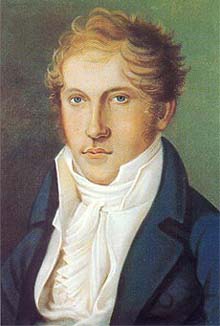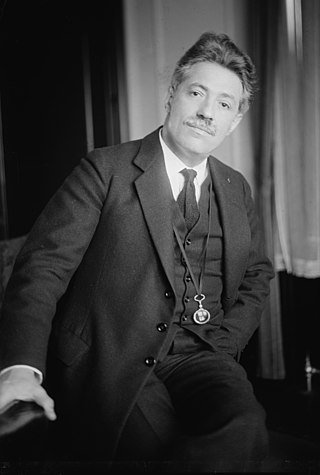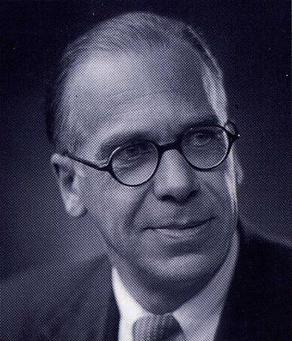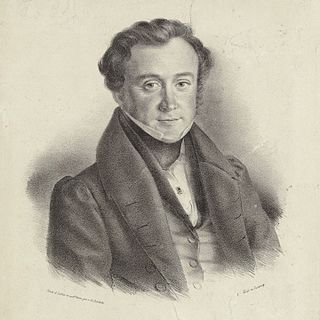Related Research Articles
A concerto is, from the late Baroque era, mostly understood as an instrumental composition, written for one or more soloists accompanied by an orchestra or other ensemble. The typical three-movement structure, a slow movement preceded and followed by fast movements, became a standard from the early 18th century.

Carl Maria Friedrich Ernst von Weber was a German composer, conductor, virtuoso pianist, guitarist, and critic of the early Romantic period. Best known for his operas, he was a crucial figure in the development of German Romantische Oper.

Carl Philipp Stamitz was a German composer of partial Czech ancestry. He was the most prominent representative of the second generation of the Mannheim School.

Louis Spohr, baptized Ludewig Spohr, later often in the modern German form of the name Ludwig was a German composer, violinist and conductor.

Friedrich "Fritz" Kreisler was an Austrian-born American violinist and composer. One of the most noted violin masters of his day, and regarded as one of the greatest violinists of all time, he was known for his sweet tone and expressive phrasing. Like many great violinists of his generation, he produced a characteristic sound which was immediately recognizable as his own. Although it derived in many respects from the Franco-Belgian school, his style is nonetheless reminiscent of the gemütlich (cozy) lifestyle of pre-war Vienna.

Johann Wenzel Anton Stamitz was a Bohemian composer and violinist. His two surviving sons, Carl and Anton Stamitz, were composers of the Mannheim school, of which Johann is considered the founding father. His music is stylistically transitional between the Baroque and Classical periods.

The Piano Concerto No. 1 in D minor, Op. 15, is a work for piano and orchestra completed by Johannes Brahms in 1858. The composer gave the work's public debut in Hanover, the following year. It was his first-performed orchestral work, and his first orchestral work performed to audience approval.

Symphony No. 40 in G minor, K. 550 was written by Wolfgang Amadeus Mozart in 1788. It is sometimes referred to as the "Great G minor symphony", to distinguish it from the "Little G minor symphony", No. 25. The two are the only extant minor key among Mozart's symphonies.

The Symphony No. 1 in D major, Op. 25, also known as the Classical, was Sergei Prokofiev's first numbered symphony. He began to compose it in 1916 and completed it on September 10, 1917. It was composed as a modern reinterpretation of the classical style of Joseph Haydn and Wolfgang Amadeus Mozart. The symphony's nickname was bestowed upon it by the composer. It premiered on April 18, 1918, in Petrograd, conducted by Prokofiev. It has remained one of his most popular works.
Benjamin Frankel was a British composer. His best known pieces include a cycle of five string quartets, eight symphonies, and concertos for violin and viola. He was also notable for writing over 100 film scores and working as a big band arranger in the 1930s. During the last 15 years of his life, Frankel also developed his own style of 12-note composition which retained contact with tonality.

Per Nørgård is a Danish composer and music theorist. Though his style has varied considerably throughout his career, his music has often included repeatedly evolving melodies—such as the infinity series—in the vein of Jean Sibelius, and a perspicuous focus on lyricism. Reflecting on this, the composer Julian Anderson described his style as "one of the most personal in contemporary music". Nørgård has received several awards, including the 2016 Ernst von Siemens Music Prize.
Gordon Percival Septimus Jacob CBE was an English composer and teacher. He was a professor at the Royal College of Music in London from 1924 until his retirement in 1966, and published four books and many articles about music. As a composer he was prolific: the list of his works totals more than 700, mostly compositions of his own, but a substantial minority of orchestrations and arrangements of other composers' works. Those whose music he orchestrated range from William Byrd to Edward Elgar to Noël Coward.

William Alwyn, was an English composer, conductor, and music teacher.
In music, a nonet is a chamber music composition which requires nine musicians for a performance. The standard nonet scoring is for wind quintet, violin, viola, cello, and double bass, though other combinations are also found. Additionally, the term may apply to a group of nine musicians regardless of whether they are playing chamber music.

Jan Křtitel Václav Kalivoda was a composer, conductor and violinist of Bohemian birth.
Joseph Küffner (Kueffner) was a German musician and composer who, among other achievements, contributed significantly to the guitar repertory, including chamber music.
František Xaver Pokorný was a Czech composer and violinist of the classical period.
Philip Christian Darnton, also known as Baron von Schunck, was a British composer and writer.
Joseph Touchemoulin was a French violinist and composer of the classical period who mainly worked in Bonn and Regensburg.

Henricus Josephus de Croes, Hendrik Jozef de Croes, known as Henri-Joseph de Croes was a Flemish composer and violinist. He was Kapellmeister of the court orchestra of the Thurn und Taxis in Regensburg. He composed symphonies, various clarinet concertos, partitas, divertimenti and a Singspiel or opera.
References
- ↑ Rice, Albert R. (2003). The Clarinet in the Classical Period at Google Books. Oxford University Press. page 250. ISBN 0-19-514483-X.
- ↑ Orfeo C 290 931 A, 1993, with works for 1-3 clarinets and orchestra, Oliver Link the 2nd clarinetist. A copy is still at University of Virginia Libraries.
- ↑ Colin Lawson (May 1996). Mozart: Clarinet Concerto. Cambridge University Press. p. 15. ISBN 9780521479295 . Retrieved 23 September 2022.